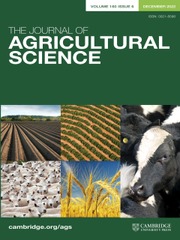Crossref Citations
This article has been cited by the following publications. This list is generated based on data provided by
Crossref.
Cooper, J P
and
Edwards, K J R
1961.
The genetic control of leaf development in Lolium.
Heredity,
Vol. 16,
Issue. 1,
p.
63.
Lambert, D. A.
1962.
A study of growth in swards of timothy and meadow fescue III. The effect of two levels of nitrogen under two cutting treatments.
The Journal of Agricultural Science,
Vol. 59,
Issue. 1,
p.
25.
Jameson, Donald A.
1963.
Responses of individual plants to harvesting.
The Botanical Review,
Vol. 29,
Issue. 4,
p.
532.
Broadbent, P. J.
1963.
THE USE OF GRAZING CONTROL FOR INTENSIVE FAT‐LAMB PRODUCTION.
Grass and Forage Science,
Vol. 18,
Issue. 4,
p.
280.
Ryle, G. J. A.
1964.
A COMPARISON OF LEAF AND TILLER GROWTH IN SEVEN PERENNIAL GRASSES AS INFLUENCED BY NITROGEN AND TEMPERATURE.
Grass and Forage Science,
Vol. 19,
Issue. 3,
p.
281.
Anslow, R. C.
1965.
GRASS GROWTH IN MIDSUMMER*.
Grass and Forage Science,
Vol. 20,
Issue. 1,
p.
19.
Cowling, D. W.
1966.
The effect of the early application of nitrogenous fertilizer and of the time of cutting in spring on the yield of rye-grass/white clover swards.
The Journal of Agricultural Science,
Vol. 66,
Issue. 3,
p.
413.
Tayler, J. C.
and
Rudman, J. E.
1966.
The distribution of herbage at different heights in ‘grazed’ and ‘dung patch’ areas of a sward under two methods of grazing management.
The Journal of Agricultural Science,
Vol. 66,
Issue. 1,
p.
29.
Agyare, J. A.
and
Watkin, B. R.
1967.
SOME EFFECTS OF GRAZING MANAGEMENT ON THE YIELD AND ITS COMPONENTS OF SOME PASTURE GRASSES.
Grass and Forage Science,
Vol. 22,
Issue. 3,
p.
182.
Anslow, R. C.
and
Green, J. O.
1967.
The seasonal growth of pasture grasses.
The Journal of Agricultural Science,
Vol. 68,
Issue. 1,
p.
109.
Anslow, R. C.
1967.
Frequency of cutting and sward production.
The Journal of Agricultural Science,
Vol. 68,
Issue. 3,
p.
377.
Hodgson, J.
and
Ollerenshaw, J. H.
1969.
THE FREQUENCY AND SEVERITY OF DEFOLIATION OF INDIVIDUAL TILLERS IN SET‐STOCKED SWARDS.
Grass and Forage Science,
Vol. 24,
Issue. 3,
p.
226.
Walton, P. D.
and
Murchison, C.
1979.
A plant ideotype for Bromus inermis Leyss. in Western Canada.
Euphytica,
Vol. 28,
Issue. 3,
p.
801.
Heide, Ola M.
1982.
Effects of Photoperiod and Temperature on Growth and Flowering in Norwegian and British Timothy Cultivars(Phleum PratenseL.).
Acta Agriculturae Scandinavica,
Vol. 32,
Issue. 3,
p.
241.
Hay, R. K. M.
and
Heide, O. M.
1983.
Specific photoperiodic stimulation of dry matter production in a high‐latitude cultivar of Poa pratensis.
Physiologia Plantarum,
Vol. 57,
Issue. 1,
p.
135.
Kornher, A.
and
Taube, F.
1987.
Wachstumsanalytische Untersuchungen an Knaulgras (Dactylis glomerata L.) unter besonderer Berücksichtigung des phänologischen Entwicklungsstadiums bei der Nutzung im ersten Aufwuchs.
Journal of Agronomy and Crop Science,
Vol. 159,
Issue. 2,
p.
119.
Davies, Alison
1988.
The Grass Crop.
p.
85.
Taube, F.
1990.
Growth Characteristics of Contrasting Varieties of Perennial Ryegrass (Lolium perenne L.).
Journal of Agronomy and Crop Science,
Vol. 165,
Issue. 2-3,
p.
159.
Jørgensen, M.
and
Nösberger, J.
1994.
Competitive Interactions between First‐year Seedlings of Timothy (Phleum pratense L.) and Meadow Fescue (Festuca pratensis Huds.).
Journal of Agronomy and Crop Science,
Vol. 173,
Issue. 2,
p.
135.
Jösrgensen, M.
and
Junttila, O.
1994.
Competition Between Meadow Fescue (Festuca pratensis Huds.) and Timothy (Phleum pratense L.) at Three Levels of Nitrogen Fertilization, During Three Growing Seasons.
Journal of Agronomy and Crop Science,
Vol. 173,
Issue. 5,
p.
326.




